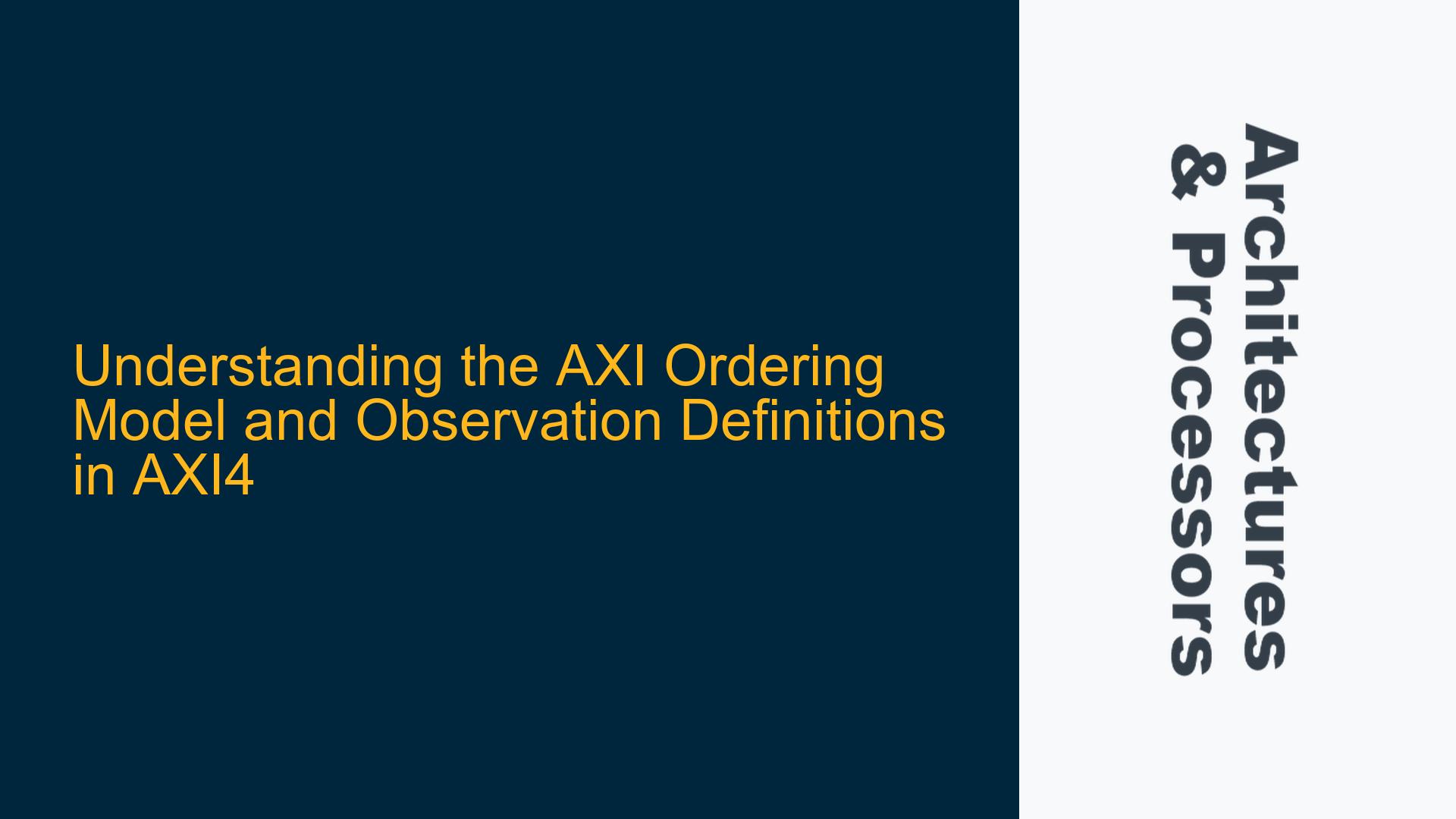AXI4 Ordering Model and the Concept of Observation in Memory Transactions
The AXI4 protocol, a widely used on-chip communication standard, defines a robust and flexible ordering model that governs how transactions are observed and completed in a multi-master, multi-slave system. At the heart of this model lies the concept of "observation," which is critical for understanding how memory operations are perceived and synchronized across different components in an ARM-based system. The AXI4 specification, particularly in section A6.4, introduces the term "observation" to describe the visibility of transactions within the system. This term is not merely abstract but is rigorously defined to ensure consistency and predictability in memory operations.
In the context of AXI4, a transaction is considered "observed" when its effects are visible to a specific component or agent in the system. For example, if a write transaction is observed by a read transaction, it means that the read operation sees the updated data from the write operation. This concept is essential for maintaining coherency and ensuring that the system behaves predictably, especially in scenarios involving multiple masters, caches, and memory regions.
The AXI4 ordering model is designed to handle complex interactions between transactions, ensuring that dependencies are respected and that the system adheres to the specified memory ordering rules. The term "observation" is used to define the point at which a transaction’s effects become visible to other transactions. This visibility is not instantaneous but depends on the ordering rules defined by the AXI4 protocol. Understanding these rules is crucial for debugging and optimizing systems that rely on AXI4 for communication.
Memory Ordering Rules and the Role of Observation in AXI4
The AXI4 protocol enforces specific memory ordering rules to ensure that transactions are observed in a consistent and predictable manner. These rules are defined in terms of the "observation" and "completion" of transactions. A transaction is considered complete when it has been fully executed and its effects are visible to all relevant components in the system. However, the observation of a transaction by another transaction depends on the ordering model and the specific rules that govern the interaction between the two.
One of the key challenges in understanding the AXI4 ordering model is the abstract nature of the term "observation." In the context of memory transactions, observation refers to the point at which the effects of a transaction become visible to another transaction. For example, if a write transaction is followed by a read transaction to the same memory location, the read transaction must observe the write transaction to ensure that it reads the updated data. This is a fundamental requirement for maintaining data consistency in the system.
The AXI4 protocol defines several ordering rules that govern how transactions are observed. These rules include:
-
Write-to-Read Ordering: A read transaction that follows a write transaction to the same memory location must observe the write transaction. This ensures that the read operation sees the updated data from the write operation.
-
Read-to-Read Ordering: Read transactions to the same memory location must be observed in the order they were issued. This ensures that the system maintains a consistent view of memory.
-
Write-to-Write Ordering: Write transactions to the same memory location must be observed in the order they were issued. This ensures that the final state of memory reflects the correct sequence of write operations.
-
Read-to-Write Ordering: A write transaction that follows a read transaction to the same memory location must not be observed before the read transaction. This ensures that the read operation sees the correct data before the write operation updates it.
These ordering rules are enforced by the AXI4 protocol to ensure that the system behaves predictably and consistently. However, the implementation of these rules can vary depending on the specific architecture and configuration of the system. For example, in systems with multiple masters and caches, additional mechanisms such as cache coherency protocols may be required to ensure that transactions are observed correctly.
Debugging and Optimizing AXI4 Systems: Ensuring Correct Observation of Transactions
When working with AXI4-based systems, it is essential to ensure that transactions are observed correctly to avoid subtle bugs and performance bottlenecks. Incorrect observation of transactions can lead to data corruption, race conditions, and other issues that are difficult to diagnose and resolve. To address these challenges, it is important to understand the underlying mechanisms that govern the observation of transactions in AXI4 systems.
One common issue in AXI4 systems is the incorrect ordering of transactions, which can result in transactions being observed out of order. This can occur due to a variety of reasons, including the use of out-of-order execution, the presence of multiple masters, and the use of caches. To debug and resolve these issues, it is important to carefully analyze the sequence of transactions and ensure that they adhere to the ordering rules defined by the AXI4 protocol.
Another common issue is the lack of proper synchronization between transactions, which can result in transactions being observed before they are complete. This can occur when transactions are issued without the necessary memory barriers or synchronization primitives. To address this issue, it is important to use the appropriate synchronization mechanisms, such as memory barriers, to ensure that transactions are observed in the correct order.
In addition to debugging, optimizing the performance of AXI4 systems requires a deep understanding of the observation model and the factors that influence the visibility of transactions. For example, in systems with multiple masters, it is important to minimize contention and ensure that transactions are observed as quickly as possible. This can be achieved by optimizing the arbitration logic, reducing the latency of memory accesses, and using techniques such as transaction reordering to improve throughput.
To summarize, the AXI4 ordering model and the concept of observation are critical for understanding how transactions are processed and synchronized in ARM-based systems. By carefully analyzing the ordering rules and ensuring that transactions are observed correctly, it is possible to build robust and high-performance systems that meet the demands of modern embedded applications. Whether you are debugging a complex issue or optimizing the performance of your system, a deep understanding of the AXI4 ordering model is essential for success.






